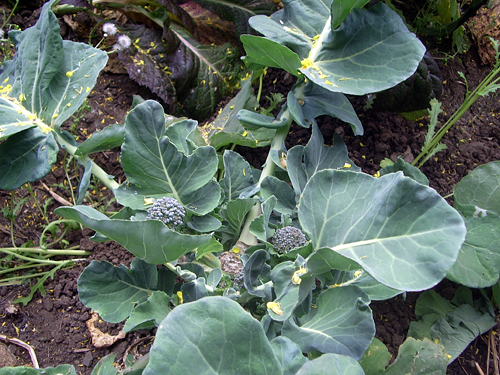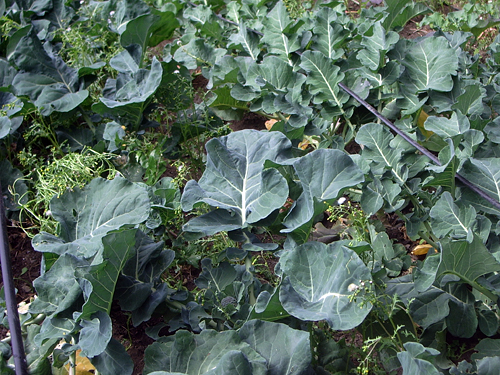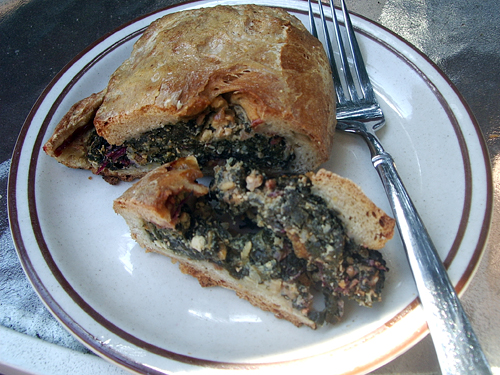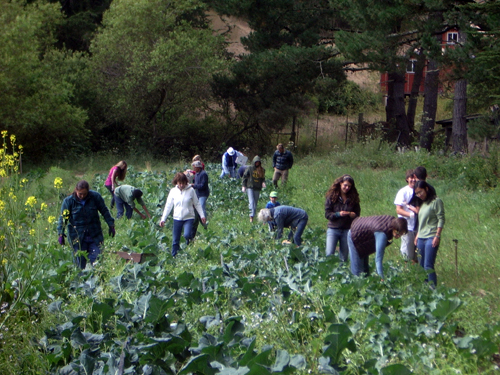Every Monday, Scott Davidson, Marin Organic's School Lunch and Gleaning Program Manager, meets up with an all-ages group of volunteers at a selected farm. The task is simple: go through rows that have already been harvested for sale, and pick the best of what's left. The produce is boxed, rinsed, and loaded onto Marin Organic's truck. Cooled overnight, it's delivered the next day to schools, camps, and/or after-school programs all over Marin, either for free or at very low cost.
Fresh, nutritious, locally-grown produce goes to the kitchen and turns into lunch--and because there's no cost to the farm, and very little cost in labor, participating schools actually save money, money that can then be spent on getting more healthy food to their students.
Anyone with a couple of hours free on a Monday afternoon can join the Glean Team. Sign up online or over the phone, and an email detailing the next week's location will be sent to you every Friday. Usually, the location flip-flops between Green Gulch and Star Route, with a few other farms making occasional appearances.
Wear a jacket and don't-mind-getting-muddy shoes, and bring a few tote and/or plastic bags for your post-gleaning haul. (After the gleaning is done, volunteers can go through the harvested section yet again and pick for themselves.)
Last Monday, we left a hot, sunny afternoon in Oakland for the cool, foggy twists of the Shoreline Highway, bumping down the eucalyptus-lined road to the Zen Center's Green Gulch Farm. As you might expect from a longtime Buddhist retreat cupped close to the ocean, the whole place is soaked in peace and abundantly quiet. The joy jumps out in color: ravishingly purple bursts of lavender, whorled-pink roses, black-red pincushion flowers, vermillion-tipped raspberry canes and espaliered apples and pears weighted with green-and-gold fruit. Yellow-spattered mustard plants gone to flower reach up six feet high over the broccoli and cabbage rows we've come to harvest.
These weed-laced rows are going to be mowed under tomorrow, Scott tells us. The biggest, fattest heads of broccoli and cauliflower have already been picked, but sharp eyes can find side shoots, mini-heads growing next to where the main stalk was broken off. These tender, bite-sized florets are gold to school-kitchen chefs, he tells us, easy to cook and easy to eat.

We fan out down the rows. Everyone likes the hunt, especially the teenage boys in the crew. The leaves are huge and heavy, hiding the score, but underneath, the tender stalks snap easily and our recycled waxed-cardboard boxes fill up fast. We move onto small, loosely curled heads of cabbage, then over to red-veined plumes of ruby chard, puckery dino kale and curled Bloomsdale spinach.
We're mindful to take only the best-looking stuff, part of the education process of eating local and organic. Because it's being given away, it has to look better, even, than what's bought: No one, even a cash-strapped camp or school, wants to feel like a dumping ground for wormy charity carrots, no matter how much Vitamin A they might provide. It's not hard, however: there are still plenty of lovely greens left, enough to fill at least twenty-five or thirty boxes, if not more.

Scott points out the clumps of nettles growing in between the rows. This weed is probably the most nutritious thing growing on the farm (sellable for at least $6 a pound at a farmers' market) but the leaves will cause a brief, itchy sting if touched. They do leave their mark on my wrists and knees as I pick, but I don't mind: I've happily paid good money for nettle soup and nettle pasta at Delfina. Tomorrow's breakfast will be emerald eggs, scrambled with sauteed nettles. (Once cooked, they're harmless and delicious, especially rich in B vitamins. Just wear gloves, or use tongs, when working with the raw item.)
By six o'clock, the boxes are neatly stacked in the truck. Now we can go over the rows one more time, picking for ourselves. Now I'm not so particular: holey chard, nettle tips, tiny volunteer beets and potatoes all go into my bag. We'll be living off this bounty for a few days at least, while back at the farm, the tractor will be turning under the last few roots and leaves, making room for a new planting.

Green Gulch Greens Pie
This adaptable, calzone-like pie is inspired by Greek spanikopita. You could easily replace the yeast dough with six or seven sheets of defrosted phyllo dough, brushing melted butter between each sheet before filling and sealing.
Any mixture of reasonably tender greens will work here, including chard, spinach, orach, mustard, radish or turnip tops, lacinato (dino) kale, and beet greens. If you want to add in some tougher greens, like collards, kale, or broccoli leaves, be sure to shred them very finely so they'll cook as fast as the softer greens. A handful of strongly flavored greens, like arugula, parsley, or sorrel can be tossed in as an accent.
Makes 2 pies, enough to serve 6-8
Ingredients:
For dough:
1 1/2 tsp yeast (1/2 package)
3/4 cup lukewarm water
2 cups all-purpose white flour, or 1 cup white flour mixed with 1 cup whole wheat flour
1 tbsp cornmeal
1 tsp salt
1 tbsp olive oil
For filling:
approximately 10 cups shredded mixed greens
1 large onion, peeled and diced (about 1 cup)
4 cloves garlic, peeled and chopped
2 tablespoons olive oil
1/4 tsp freshly grated nutmeg, or to taste
Juice and grated rind of 1 lemon
2 oz. feta cheese, crumbled
1 oz. ricotta salata, crumbled
Salt, if needed
2 eggs
2 tbsp raw rice
Egg wash (optional): 1 egg yolk beaten with 1 tbsp water
Preparation:
1. To make dough: Dissolve yeast in water and let sit for a few minutes. In a large bowl, stir together flour, cornmeal and salt. Pour in yeast mixture and olive oil. Stir to make a pliable dough.
2. On a lightly floured surface, knead dough for 5-8 minutes, until it feels springy and elastic. Rinse out bowl, coat lightly with olive oil, and return dough to the bowl, turning to coat with oil.
3. Cover bowl with a clean damp towel and let dough rise in a warm place until doubled in bulk, about 1 1/2 hours. Punch down and divide dough in two.
4. While dough is rising, make filling: Place a large saute pan over medium-low heat. Add oil, then onions and garlic. Cook, stirring frequently, until onions are soft and translucent but not browned.
5. Add greens by the handful, stirring, until they collapse and cook down. (You make have to do this in batches, removing the already cooked greens to a separate bowl.)
6. When all the greens are cooked, add nutmeg, lemon juice and lemon rind, and crumbled cheeses. Let cool slightly, and taste for seasoning, adding salt if needed. Stir in rice and beaten eggs, and let sit for 15 minutes.
7. To assemble, preheat oven to 375F. Roll and stretch one dough ball into a long oval. Lightly grease a large rimmed baking sheet. Place dough on sheet. Cover half the oval with greens filling, leaving an inch-wide margin. Fold over remaining dough and pinch together to seal. Repeat with remaining portion of dough.
8. If desired, brush pies with egg wash. Bake for 45-50 minutes, until dough is firm and golden brown.



